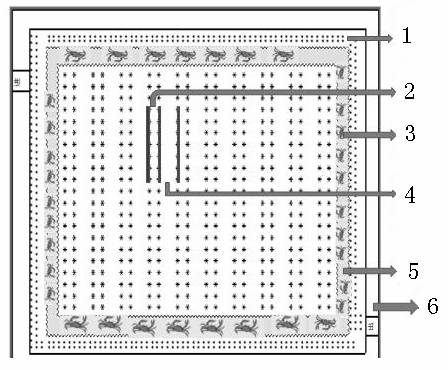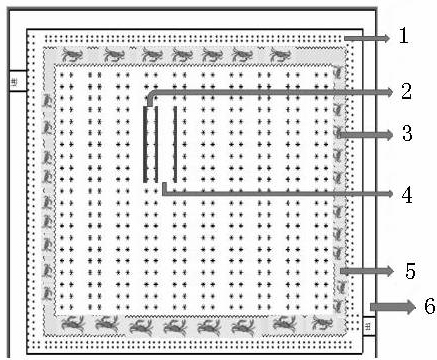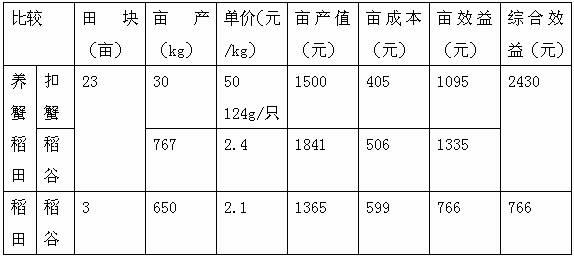Method for breeding adult crabs in rice fields
A technology for paddy fields and adult crabs, which is applied in the field of aquatic ecological breeding, can solve the problems of natural river crab reduction, achieve the effects of reducing agricultural costs, increasing production, and controlling pesticide pollution
- Summary
- Abstract
- Description
- Claims
- Application Information
AI Technical Summary
Problems solved by technology
Method used
Image
Examples
Embodiment 1
[0035] Embodiment 1 Paddy field culture of the present invention becomes the method for crab
[0036] Please refer to the attached figure 1 , with figure 1 It is a schematic diagram of growing crabs in paddy fields according to the present invention.
[0037] The method for growing crabs in paddy fields of the present invention adopts rice, first-year-old crab species, soybeans ( Glycine max ) Trinity three-dimensional ecological planting model, including the following steps:
[0038] (1) Select paddy fields for cultivating adult crabs: the paddy fields for cultivating adult crabs are selected near water sources, with good water quality, no pollution, convenient drainage and irrigation, strong water and fertilizer retention capabilities, not submerged during flood seasons, and large contiguous areas. Low-lying, shallow waters.
[0039] (2) Select the first-age crab species and carry out temporary breeding: catch the first-age crab species from the overwintering pond, an...
Embodiment 2
[0062] Please refer to the attached figure 1 , with figure 1 It is a schematic diagram of the rice field growing crab of the present invention.
[0063] (1) Selection of paddy fields: Crab-raising paddy fields should be selected in low-lying and shallow areas close to water sources, with good water quality, no pollution, convenient drainage and irrigation, strong water and fertilizer retention, not submerged during flood seasons, and large contiguous areas.
[0064] (2) Selection of rice seeds: Rice seeds should choose varieties that are resistant to pests and diseases, lodging, saline and alkali, fertility, high quality and high yield, and choose Yanfeng No. 47 rice variety.
[0065] (3) Selection of first-year-old crab species: first-year-old crab species are cultivated by themselves in the previous year. Catch the first-year-old crab species from the overwintering pond, and put them in the holding pond next to the paddy field for temporary cultivation. After moulting once...
Embodiment 3
[0087] During May-October, 2009, in Baqiang Town, Panshan County, Panjin City, Liaoning Province, a rice field crab cultivation demonstration area was implemented, and the method steps of Embodiment 1 were adopted to cultivate crabs in rice fields at the rice field cultivation crab demonstration base. Star No. 1 rice, and chose to stock crabs with neat specifications in mid-June, with an average of 12.5g / piece, 400 / mu. As a result, the average adult crabs caught in early October were 124g / piece, with an average of 30 kg / mu; the rice yield was average 767 kg / mu, as shown in Table 1.
[0088] Table 1 Comparison of yield and benefit between rice fields with crab and conventional rice fields (2009)
[0089]
[0090] As can be seen from Table 1: the input-output ratios of crab paddy fields and conventional paddy fields are respectively: 1:3.67 and 1:2.28; the average 124g / of crabs, an average of 30 kg / mu, and due to the paddy field culture adopted in the present embodiment The...
PUM
 Login to View More
Login to View More Abstract
Description
Claims
Application Information
 Login to View More
Login to View More - R&D
- Intellectual Property
- Life Sciences
- Materials
- Tech Scout
- Unparalleled Data Quality
- Higher Quality Content
- 60% Fewer Hallucinations
Browse by: Latest US Patents, China's latest patents, Technical Efficacy Thesaurus, Application Domain, Technology Topic, Popular Technical Reports.
© 2025 PatSnap. All rights reserved.Legal|Privacy policy|Modern Slavery Act Transparency Statement|Sitemap|About US| Contact US: help@patsnap.com



